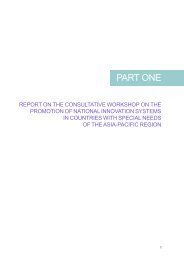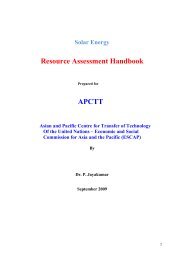• NEF to fund R&D for applications, innovative new ideas and fundamental researchby universities, institutes and individuals.While NEF with a corpus of nearly Rs 10 billion (US$196.56 million) has been created,there is no policy framework as yet for its effective utilization for driving R&D. AdvancedFFTs for sustainable power generation must be considered a priority area to gainfullyuse NEF and develop appropriate technologies for domestic applications.A wide range of LCETs for power generation have the potential to contribute significantlyto reduction of carbon emissions worldwide, but virtually all of them will require somekind of substantial intervention – fundamental innovation, technology development,demonstration at market scale, market incentive, etc. – to change the deploymentcourse that these technologies are already on throughout much of the world. That is, asubstantially increased role for LCETs will likely require substantial interventions,especially over the next two decades, if they are to make a significant difference inreduction of emissions by 2050.A number of the most promising possible initiatives to profoundly influence thedevelopment and rate of adoption of LCETs are common to all such technologies, suchas: various mechanisms that place an actual or de facto price on carbon; expansion,improved control and efficiency of electric power transmission and distribution; anddevelopment and deployment of electricity storage or other mechanisms for dealingwith generation variability common to many of the relevant emerging technologies.The rate of increase in energy demand is among the most important factors necessitatingLCETs. World Energy Outlook 2011 presents a scenario that traces an energy pathconsistent with meeting the globally agreed goal of limiting the temperature rise to2°C. By that path, 80 per cent of the total energy-related CO 2emissions permissibleby 2035 are already locked in by existing capital stock (power plants, factories, buildings,etc.). Moreover, if significant progress in reduction of global carbon emissions is notachieved by 2017, then emissions from existing facilities leave no room at all for additionalinfrastructure, unless expansion involves zero net increase in carbon emissions.The rate of increase in energy demand also influences the scale and unit size of powergeneration technologies most suitably deployed to meet that demand. Large-scale,large unit size power plants with long construction lead times are typically only practicalat high rates of demand growth with relative certainty that such demand will materialize.Smaller scale, more modular power plants with shorter lead times are generally bettermatched to meeting uncertain and lower rates of demand growth. However, with a largepopulation of smaller scale modular power plants, instead of larger central scale plants,the transmission and distribution system would need to be configured and controlledquite differently, especially if the system involves coordination of intermittent generation,such as solar or wind, and associated storage and or generators with load followingcapabilities.Finally, and perhaps most importantly, the relative success of increasing energyefficiency will dramatically affect the rate of demand growth and hence both the needfor and the type of technology most suitable for generation expansion.The reason such a strategy is important for low-carbon power generation technologiesis that it provides a window of additional time and opportunity for emerging technologies38
to mature and become more cost-competitive. This might reduce the necessity or atleast the intensity of other kinds of policy initiatives to encourage deployment. In short,by far the most promising options for both reducing carbon emissions and profoundlyaffecting the prospects of most, if not all, power generation technologies to reduceemissions are efforts to develop and deploy technologies and other means of promotingimproved energy efficiency.In addition to promising initiatives that apply to essentially all LCETs, each technologyhas its own features limiting the rate of commercial deployment. Some technologiesrequire substantial continued development or fundamental innovation, despite being ona fast development track already, to reduce cost or mitigate performance risks andcompete with traditional options. Many have geographic constraints that limit theirpotential in many parts of the world. Tragic or costly experiences with some quitemature technologies have led to deployments at much reduced rates than expected.The LCETs identified in these conditions are described below.A. Hydroelectric powerHydroelectric power generation is for the most part a mature, well-developed and widelydeployed technology. This is especially true for large-scale hydropower, although modestincreases in turbine efficiency can still yield significant increases in capacity even atexisting facilities. As the prospect for new large-scale hydropower worldwide is modestand geographically concentrated, an engineering initiative to examine the potential forcapacity expansion might be the most important and immediate step required in existinglarge-scale facilities. Small-scale hydropower has much more potential for substantiallyincreased deployment, but the obstacles are much more site-specific. It is possiblethat more standardized designs could help facilitate faster deployment, especially incountries with large sparsely populated land areas.B. Solar electric powerThe most promising and possible initiatives for accelerating the deployment of solartechnologies vary considerably by technology, especially for photovoltaics (PV) versussolar thermal or concentrating solar power (CSP), although there are some initiativesthat could dramatically affect the prospects of all solar technologies.Despite significant cost reductions in recent years, the prospects of PV hinge largelyon further cost reductions in both raw materials and fabrication of PV cells and modules.Manufacturing economies realized through automation in large capacity plants for siliconbasedPVs, utilization of lower cost commodity elements such as copper, zinc andtin, continued development of organic hybrid PV cells, etc. are useful efforts in thisdirection. The most promising initiatives that address both these cost dimensions areaccelerated R&D and building platforms for large-scale deployment. Additional factorsthat affect cost vary with location and include cost of land, options of orientation (e.g.,rooftops), level of solar insolation and perhaps the availability of power networkinterconnection and regulatory policies affecting that interconnection. Cost is the majorfactor limiting the rate of deployment of CSP technologies as well. In many respects,CSP technologies are relatively mature in terms of basic technology design andconfiguration. Although additional R&D will continue to bring costs down, increased39
- Page 1 and 2: ADVANCES IN FOSSIL FUELTECHNOLOGIES
- Page 3 and 4: ADVANCES IN FOSSIL FUELTECHNOLOGIES
- Page 5 and 6: CONTENTSABBREVIATIONSiiiPART ONEREP
- Page 7 and 8: ABBREVIATIONSAC : Alternating curre
- Page 9: OECD : Organization for Economic Co
- Page 12 and 13: IORGANIZATION OF THE WORKSHOPA. Bac
- Page 14 and 15: D. Election of officersThe followin
- Page 16 and 17: IIICONSIDERATION OF ISSUESA. Backgr
- Page 18 and 19: emissions. Underground coal gasific
- Page 20 and 21: 800 MWe, a steam pressure of 300 kg
- Page 22 and 23: • Materials development & manufac
- Page 24 and 25: Figure 1-5: Strategy for commercial
- Page 26 and 27: tonnes, the state-owned enterprise
- Page 28 and 29: • Ensuring not just easy FDI entr
- Page 30 and 31: MW ultra-supercritical units; and s
- Page 32 and 33: the captive generation capacity) on
- Page 34 and 35: and other financial institutions -
- Page 36 and 37: and higher efficiency power generat
- Page 38 and 39: energy technologies, which can enab
- Page 40 and 41: • Such massive financial inputs c
- Page 43 and 44: BASELINE REPORT ON FOSSIL FUEL TECH
- Page 45 and 46: B. General R&D climate in the count
- Page 47: a convenient way to envisage energy
- Page 51 and 52: emissions, at least relative to sin
- Page 53 and 54: The Ministry of Power (MoP), which
- Page 55 and 56: 3. Bio-energyBio-energy, widely ava
- Page 57 and 58: in such a canal will rotate at a lo
- Page 59 and 60: in tackling climate change. A one p
- Page 61 and 62: Advantages of supercritical plants
- Page 63 and 64: existing power plants but also to b
- Page 65 and 66: BASELINE REPORT ON FOREIGN DIRECT I
- Page 67 and 68: CEA at 598 mt. This is mainly due t
- Page 69 and 70: For India to maintain its momentum
- Page 71 and 72: Table 2-5: Electricity generation t
- Page 73 and 74: Growth, which submitted its interim
- Page 75 and 76: 3. Future challengesThe future chal
- Page 77 and 78: development worked out. Public-priv
- Page 79 and 80: Linking FDI to technology transferI
- Page 81 and 82: The total requirement of fund durin
- Page 83 and 84: Funding from multilateral agenciesM
- Page 85 and 86: cooperation will be essential in so
- Page 87: Planning Commission, Government of
- Page 90 and 91: ANNEX I:LIST OF PARTICIPANTSMr. A.K
- Page 92 and 93: Mr. S.C. Shrivastava, Joint Chief (
- Page 94 and 95: ANNEX II:PROGRAMME6 June 2012, Wedn
- Page 96 and 97: ANNEX III:AN OVERVIEW OF ADVANCED F
- Page 98 and 99:
• Technology solutions are also v
- Page 100 and 101:
Table 3-5: Improvement in cycle eff
- Page 102 and 103:
• No liquid effluent formation;
- Page 104 and 105:
Figure 3-5: Advancement of gas turb
- Page 106 and 107:
Figure 3-8: Goal 2 - New clean tech
- Page 108 and 109:
Compared with conventional power pl
- Page 110 and 111:
Figure 3-14: Thermax coal gasificat
- Page 112 and 113:
ANNEX VII:GE ENERGY AND ADVANCED FO
- Page 114 and 115:
ANNEX VIII:SWOT ANALYSIS OF FOSSIL
- Page 116 and 117:
By 2035, cumulative CO 2emissions f
- Page 118 and 119:
• Falling prices of renewable ene
- Page 120 and 121:
Figure 3-20: New advanced coal powe
- Page 122 and 123:
ANNEX X:ENERGY CONSERVATION: ERDA
- Page 124 and 125:
Table 3-11: Energy cost and intensi
- Page 126 and 127:
300Figure 3-23: Trends in coal use
- Page 128 and 129:
C. Gaps in coal use efficiencyFigur
- Page 130 and 131:
ANNEX XII:FINANCING OF THE POWER SE
- Page 132 and 133:
With the entry of many private sect
- Page 134 and 135:
for future requirements should be t
- Page 136 and 137:
Short supply of coal has started af
- Page 138:
Figure 3-35: Life-cycle of technolo







